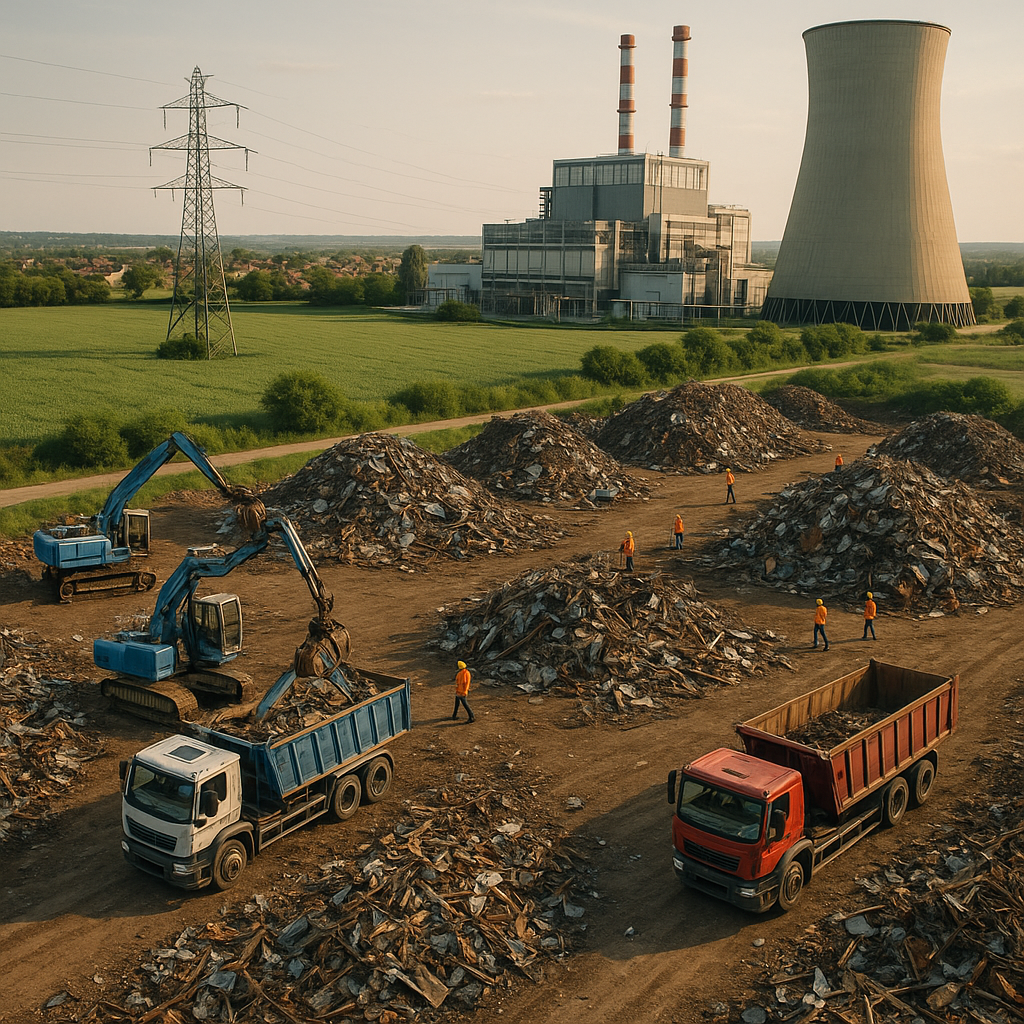5901 Botham Jean Blvd, Dallas, TX 75215
Discover the Challenges of Safely Disposing Power Plant Boilers and Turbines
August 2, 2025As power plants approach the end of their operational life, disposing of massive components like boilers and turbines becomes an increasing environmental challenge. These industrial behemoths, weighing hundreds of tons and made from various materials, cannot be discarded like regular waste.
The sheer size of these components presents significant logistical challenges. Power plant boilers often stand several stories tall, while turbines can extend longer than a football field. Dismantling these structures demands specialized equipment and expertise to ensure safety during the decommissioning process.
Material complexity adds another layer of difficulty. Modern power facilities include a mix of metals, composite materials, insulation, and potentially hazardous substances. Some components may contain materials requiring special handling protocols to prevent environmental contamination.
What are the current methods for disposing of power plant components?
Power plant decommissioning generates substantial waste streams that require proper management. The industry currently employs several methods to handle these materials, with approaches varying based on component types and environmental regulations.
Current Disposal Methods
Disposal of power plant components follows several established pathways, each with different environmental impacts and resource recovery potential:
- Landfilling – Historically the default option for many components, especially composite materials. While convenient, landfilling is increasingly scrutinized due to environmental concerns and rising costs. In the UK, landfill taxes have surged from £7 per tonne in 1996 to £72 per tonne in 2013, making this option less economical.
- Metal recycling – Well-established processes exist for recycling metal components like steel structures, copper wiring, and aluminum parts. These materials have high recovery value and strong recycling markets. Metal components typically achieve recycling rates exceeding 90% from decommissioned power plants.
- Mechanical recycling – This process involves shredding and grinding materials, followed by separation techniques to recover valuable fractions. For composite materials, mechanical recycling can separate fiber-rich and resin-rich components, though it is energy-intensive and often produces lower-quality recyclates.
- Thermal processing – High temperatures (300-1000°C) decompose resins and recover reinforcement fibers and fillers from composite materials. This can be achieved through pyrolysis, gasification, or combustion, with the added benefit of energy recovery.
The management of composite materials presents complex challenges. These materials, particularly those used in wind turbine blades, combine fibers and resins in ways that complicate separation. Their heterogeneous nature demands specialized recycling approaches.
Emerging Technologies for Composite Materials
As composite waste grows, notably from renewable energy sectors like wind power, new disposal methods are being explored:
- Chemical recycling – Uses solvents to break down and separate composite components, potentially preserving more material value than mechanical or thermal methods.
- Cement co-processing – Integrates composite waste into cement production, where materials serve as both alternative fuel and raw material substitute.
- Dross-filled packaging – In nuclear facilities, metal dross from thermal cutting is repurposed as filler material rather than being disposed of separately, reducing overall waste volume.
The choice of disposal method depends on factors like regulatory requirements, economic considerations, and environmental impact. While landfilling remains common for some components, the industry is shifting toward more sustainable approaches that recover materials and energy.
Real-World Application: Hafslund Oslo Celsio
A notable success story in power plant component management comes from Norway, where Hafslund Oslo Celsio has pioneered innovative waste-to-energy approaches. Their system not only processes municipal waste but also efficiently recovers valuable metals from the resulting ash. The facility extracts ferrous and non-ferrous metals, returning these materials to production cycles instead of sending them to landfills. This integrated approach shows how even waste from energy production can become a valuable resource stream.
Despite these advances, significant challenges remain in developing economically viable and environmentally sound methods for managing end-of-life power plant components, particularly for composite materials that were not designed with recycling in mind.
What new technologies and regulations are emerging for safer disposal?

The wind energy industry is actively developing innovative solutions to address the challenge of turbine blade disposal. Thermal decomposition recycling is one of the most promising breakthroughs. The U.S. Department of Energy’s Wind Energy Technologies Office has funded companies like Carbon Rivers to develop processes that reclaim valuable glass fibers from composite blades. These recovered materials can then be repurposed into new composite products, fostering a more circular economy for wind energy components.
Recyclable resin technology is also gaining momentum. The ZEBRA (Zero wastE Blade ReseArch) project recently produced the first 62-meter prototype blade made with Elium® thermoplastic resin. Unlike traditional thermoset resins that permanently harden, these innovative materials can be broken down at the end of their life cycle. Think of it like the difference between a hard-boiled egg (thermoset) and chocolate (thermoplastic): one can’t return to its original form when heated, while the other can be melted and reshaped repeatedly.
Mechanical recycling processes have also improved significantly. These systems shred blade materials and separate the fibers from resins, allowing the components to be repurposed as filler reinforcement in the cement or asphalt industries. The DecomBlades consortium has developed a standardized “blade material passport” to help recycling partners understand the materials they are working with, enhancing the dismantling and recycling efficiency.
On the regulatory front, several states are establishing specific requirements for wind farm decommissioning and turbine waste management. Texas, which leads in wind energy capacity, has implemented legislation defining decommissioning criteria for operators who lease land for wind farms. Similarly, Oklahoma requires energy companies to remove deactivated turbines from leased property and is exploring more sustainable waste management strategies.
Colorado lawmakers have proposed legislation that would require wind energy companies to remove decommissioned turbines from leased land to qualify for federal tax credits. This approach shifts responsibility from landowners (often farmers and ranchers) to the energy producers themselves, reflecting a growing push toward extended producer responsibility in the power generation sector.
These emerging technologies and regulations indicate a significant shift toward more sustainable practices in the wind energy industry. While challenges remain in scaling these solutions and making them cost-effective, the combined efforts of researchers, manufacturers, and policymakers are creating pathways to ensure that renewable energy remains sustainable throughout its entire lifecycle.
What are the environmental and economic impacts of power plant disposal?

Power plant disposal leads to significant environmental and economic consequences that extend beyond the decommissioning process. When these large industrial facilities reach the end of their operational life, disposal presents both challenges and opportunities.
Improper disposal of power plant components can cause serious environmental hazards. These facilities contain materials that may contaminate soil and water sources if not properly managed. For example, coal-fired plants produce ash with toxins like mercury, cadmium, and arsenic that can leach into groundwater if disposed of improperly. Nuclear facilities pose even greater challenges, as spent fuel rods and radioactive waste require specialized long-term storage solutions.
Water pollution is another critical issue. Power plants using water for cooling or steam generation must purify it before discharge. If filtration systems fail during decommissioning, pollutants can contaminate nearby water bodies, affecting local fisheries and aquatic ecosystems. Even small amounts of mercury in surface water can be absorbed by fish and enter the food chain.
The Economic Burden of Decommissioning
From an economic standpoint, power plant decommissioning costs are substantial. Decommissioning a nuclear power plant can account for 9-15% of its initial capital cost. Even when these costs are spread over a plant’s lifetime, they represent a significant financial commitment that must be planned for during operations.
Landfilling large power plant components takes up valuable space and wastes potentially recoverable materials. Traditional disposal methods miss opportunities to recover metals and other valuable resources that could be recycled back into the economy. Viewing these materials as resources rather than waste can transform the economic outlook.
Benefits of Sustainable Disposal Approaches
In contrast to these challenges, developing more sustainable disposal methods offers significant environmental and economic benefits. Advanced recycling technologies can greatly reduce the volume of waste sent to landfills. Some power plants have achieved up to an 87% reduction in waste volume through appropriate processing and resource recovery.
The economic opportunities are equally appealing. Creating a robust recycling and repurposing sector for power plant materials can generate new jobs and industries. Metals recovered from decommissioned plants can be recycled, avoiding the environmental impacts of mining new materials. Specialized facilities that process and repurpose power plant components can become economic drivers in communities affected by plant closures.
Additionally, proper disposal and recycling reduce long-term environmental liabilities. By preventing contamination, companies avoid costly cleanup operations and potential legal actions. Reusing materials also decreases the need for new resource extraction, conserving natural habitats and reducing energy consumption.
Have we fully considered the true cost of power plant disposal? Beyond the immediate expenses of decommissioning, broader impacts on community health, environmental quality, and resource sustainability suggest a need for a comprehensive approach to managing these facilities at the end of their useful lives.
Conclusion: The future of safe power plant component disposal
The power generation industry is at a pivotal point where sustainably disposing of components like boilers, turbines, and other equipment is essential. The shift towards circular supply chains presents promising solutions for reducing waste and recovering valuable materials. The recycling market for power plant components is expanding, driven by supply chain challenges and increasing environmental awareness.
The future of power plant component disposal will rely on continued advancements in recycling technologies that ensure material recovery is both environmentally friendly and economically viable. Collaboration across industries, involving researchers, manufacturers, and recycling specialists, will be crucial to developing standardized practices and creating markets for recycled materials. These partnerships, along with supportive regulatory frameworks, will help transform former waste into valuable resources for future energy infrastructure.
For your power plant decommissioning and recycling needs, contact Okon Recycling at 214-717-4083.
